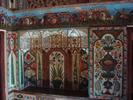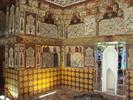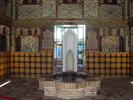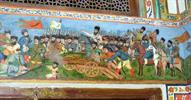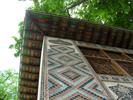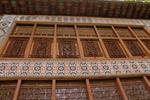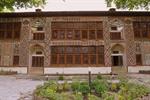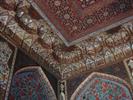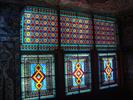Construction started 1789/1790
Completed 1797
Renovated 1848-51, 1955-65
Architect Abbasgulu (presumably)
The Palace of Shaki Khans in Shaki, Azerbaijan was a summer residence of Shaki Khans. It features decorative tiles, fountains and several stained-glass windows. The exterior is decorated with dark blue, turquoise and ochre tiles in geometric patterns and the murals were coloured with tempera and are inspired by the works of Nizami Ganjavi.
Along with its pool and plane trees, the summer residence is the only remaining structure from the larger palatial complex inside the Sheki Khans' Fortress, which once included a winter palace, residences for the Khan's family and servants' quarters. It was built in 1797 by Muhammed Hasan Khan and restored between 1952 and 1967 by a team lead of architects led by Niyazi Rzayev.
Measuring thirty-two meters by eight and a half meters on the exterior, the summer residence is a two-story masonry structure elongated on the north-south axis and covered with a wooden hipped roof with long eaves. The layout of both floors is identical; three rectangular rooms are placed in a row, separated by narrow, south-facing iwans that provide access to the rooms. The floors are accessed separately to accommodate their public and private functions. Entered from the south through the two iwans, the ground floor was used primarily by clerks and petitioners. Two stairways attached to the northern fac,ade gave access to the first floor, which was reserved for the khan's family and their guests.
The summer residence is renowned for the lavish decoration of its exterior and interior. Large portions of the residence's fac,ade, including the entire southern elevations of the central halls on both floors, are covered by a mosaic of colored glass set in a wooden latticework (shebeke) that was assembled without nails or glue. Muqarnas hoods crowning the four iwans are highlighted with gold on the lower level and covered with mirror fragments on the first floor. Remaining surfaces on all fac,ades are decorated with floral tile panels and tile mosaics.
The interior walls of the residence are covered entirely with frescoes painted at different times during the eighteenth century. Many of the frescoes feature flowers in vases, while a series of paintings on the first floor halls depict hunting and battle scenes. Signatures on frescoes list the names of artists Ali Kuli, Kurban Kuli and Mirza Jafar from Shemaha, Usta Gambar from Shusha, and Abbas Kuli, who may also have been the architect of the summer residence.
If you're planning a trip to Azerbaijan you may be interested ▶ Azerbaijan highlights - For those who prefer to go unbeaten path, to explore less visited places and check national charisma of this small country in Southern Caucasus on the edge of Europe.



